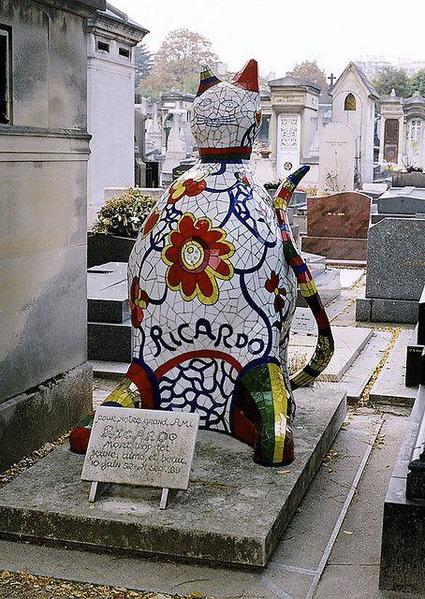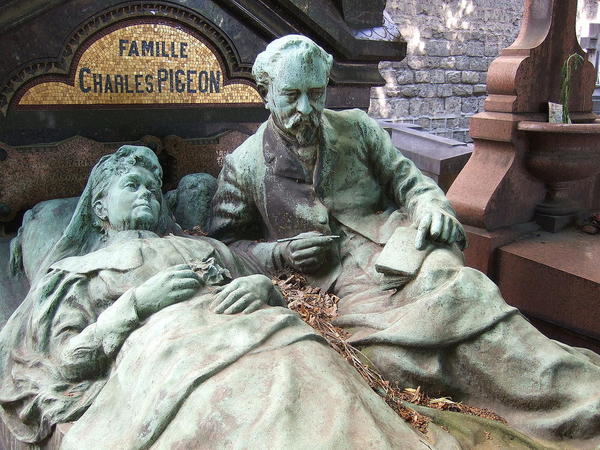Over the past few years, I've been making the rounds of Paris's three biggest cemeteries, Pere Lachaise, Montmartre, and now Montparnasse, which PortMoresby and George G recognized in our One-Clue Mystery. And as my wife and I have made the rounds and written about them, I'm faced over and over with the question: "What's the fascination?"
And the best I can offer is a few thoughts. Cemeteries offer history, sometimes in the form of a concrete reminder (the wall where Communards were shot in 1871, for example) or a name and circumstance that send us off to find 'why was that general so important?' Here is a memorial to a family whose older generation were murdered at Auschwitz, along with their daughter who was a decorated World War I nurse, and whose son died in battle in 1940.
Many large cemeteries, and the three major ones in Paris offer a quirky sort of beauty and peace, and also a reminder that no matter how grand our circumstances may seem in life, no one's footprint in life, even in an elaborate tomb, is that big.
And, oddly, they are grand opportunities for artistic freedom and fantasy, a place where even over-the-top monumentalism seems acceptable. It's also, arguably, the only place where ordinary families ever have the opportunity to take part in the selection of public sculpture—even if it will never achieve a place in a public square.
The big three cemeteries of Paris all belong to more or less the same period, the beginning of the 19th century, when for sanitary reasons as well as increasing real estate values, burials in churchyards and other city lands were barred, and broad tracts in then-distant suburbs were set aside for burial. While some graves from older cemeteries were moved there, most were reburied in the Catacombs.
Despite its once-rural setting, Montparnasse is closely-surrounded by the daily life of the city. The round tower is from a mill that predated the cemetery.
Each of the three has seemed to have a character of its own, despite the similarities. Pere Lachaise seemed to me the most consciously monumental; it is the oldest and perhaps grand monuments helped bring in customers. When we visited Montmartre Cemetery, which occupies the pit of a former quarry, I had a sense of genteel disorder, even clutter, that gave it a kind of charm.
The orderly arrangement of avenues and divisions, and the regular shape of the main cemetery, left me with an impression of Montparnasse as the most orderly and organized of the cemeteries. Even so, my pictures show little of the roads, and much of the close-packed monuments. The greenswards of 19th-century cemeteries in the U.S. and England are foreign, literally, to the cemeteries of Paris.
Montparnasse, which lies in the southern part of Paris is, like the others, still an operating cemetery. And, as in the others, the styles of monuments vary widely over time, circumstance and sentiment. Of course, there's no way, even if we had a full day there, to see every corner, every monument, or even every grave of the famous. So what you see here is only an impression of what seems to be the most 'orderly' of the three, with a regular plan and a winged statue of Eternal Sleep at the center.
 And, of course, like the other major cemeteries, it has its share of the famous and the infamous. There are artists and sculptors (Fantin-Latour, Brancusi, Bartholdi, Laurens, Houdon, and more. Playwrights such as Samuel Beckett, Eugene Ionesco and Jean Paul Sartre (yes, he wrote plays, too). Poets and writers: Baudelaire, Guy de Maupassant, Simone de Beauvoir, Marguerite Duras and more. Charles Garnier, architect of the Paris Opera. Musicians such as Cesar Frank and Saint-Saens. The list seems endless.
And, of course, like the other major cemeteries, it has its share of the famous and the infamous. There are artists and sculptors (Fantin-Latour, Brancusi, Bartholdi, Laurens, Houdon, and more. Playwrights such as Samuel Beckett, Eugene Ionesco and Jean Paul Sartre (yes, he wrote plays, too). Poets and writers: Baudelaire, Guy de Maupassant, Simone de Beauvoir, Marguerite Duras and more. Charles Garnier, architect of the Paris Opera. Musicians such as Cesar Frank and Saint-Saens. The list seems endless.
Some, like the sculptor Henri Laurens, are buried under their own work, below. Others are honored with other famous work; Brancusi's The Kiss marks the tomb of Tania Rachevskaia, a Russian anarchist who committed suicide in 1908. There are two works by Niki de Saint-Phalle, each honoring a co-worker. One, Ricardo's Cat, is above.
And it has its quirks, too. Alfred Dreyfus is buried here, and so is Porfirio Diaz, the exiled president of Mexico. Even Pierre Laval, executed for treason in 1945 after serving as premier of the puppet Vichy government is there, although for years his grave bore only the name of his wife's family. Another exile, below, was a Polish journalist and politician who ran afoul of turmoil at home.
Small, phone-booth size family tombs are among the most common forms here; they are actually, like most of the other graves, the entrance or cover for a family vault below. But, as you can see, they vary widely in style.
There are also many variations in styles of stones placed on the flat tombs; it is almost as if in death, all rules are off. Variation wider than one would find in home design is the norm here.
There are civic monuments as well, both to defenders and opponents of the state, both to Communards and to the police. Here, below, is a monument to the World War II civil defense; the role of the Defense Passive was to get people to shelters, to assist the wounded, and to make sure blackout rules were observed. Those named at the top died in that duty ('Victims of Duty'); those below, ('Morts Pour La France') honors Defense Passive members who died in the Resistance uprising of August 1944.
On a less serious note, three of my favorites. First, a truly playful, perhaps literally, tabletop of small toys. And then the grave of novelist Marguerite Duras, whose devoted followers keep the potted plants on her tomb well-supplied with pens and pencils.
And finally, perhaps the most amazing tomb I've seen anywhere, that of Charles Pigeon and his wife, lying in bed on a Sunday morning. An angel, not seen in the picture, watches over them; he holds his notebook and pen as if about to put down a thought.
Pigeon, who started out as a salesclerk at Bon Marché, invented the Pigeon Lamp, the first and perhaps only 'non-exploding' gasoline lamp in 1884. Originally designed for use by bicyclists. It was brighter and less smelly than kerosene lamps, and he quickly became rich. In 1905 he commissioned this 18-person family vault and its sculpture. His wife was buried there in 1909 and he in 1915.
Photos: Cat (UncleLynx/Flickr); Pigeon tomb, Martin Greslou/Wikimedia




Comments (1)